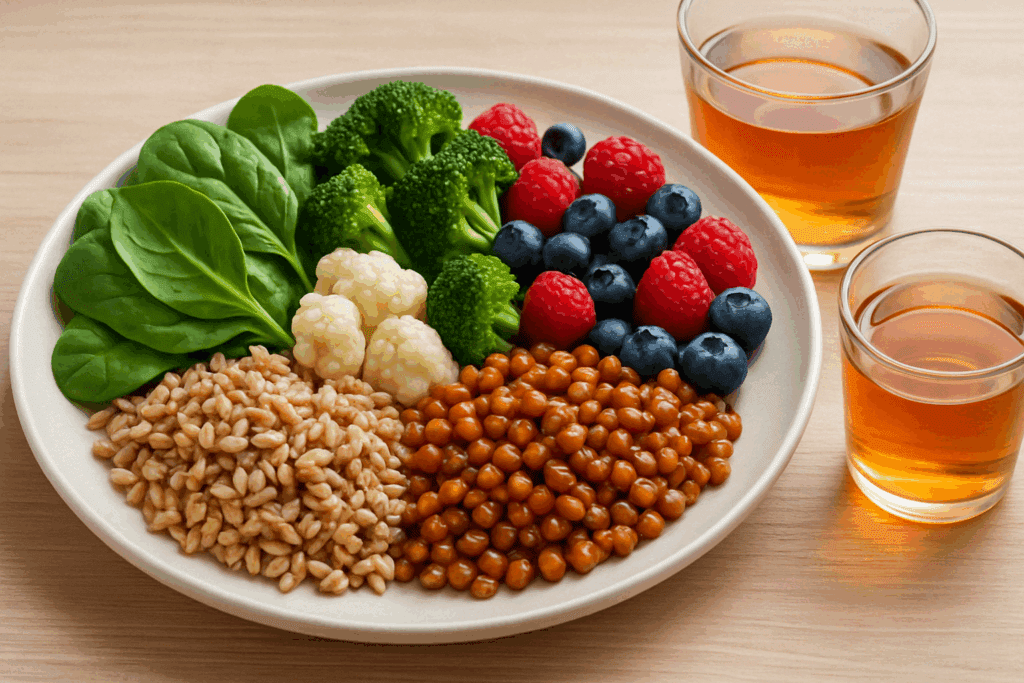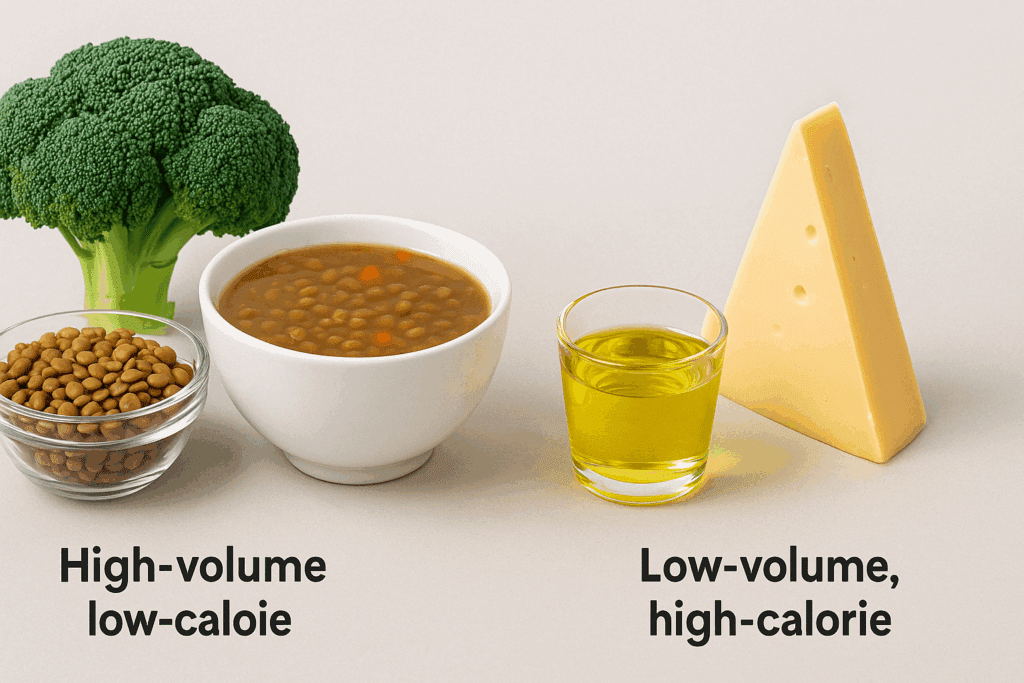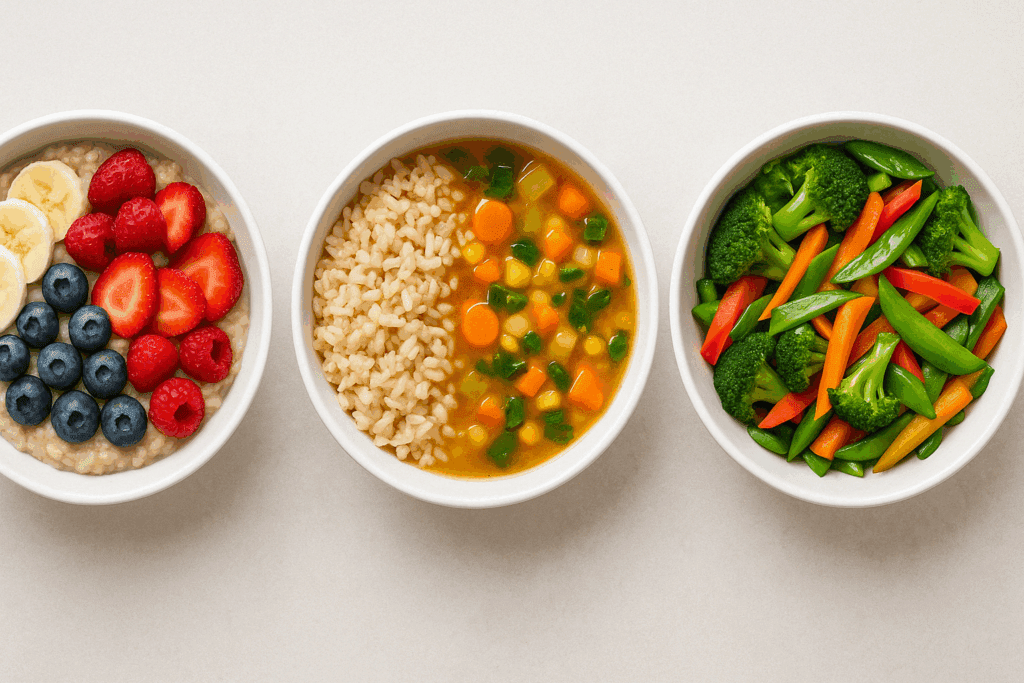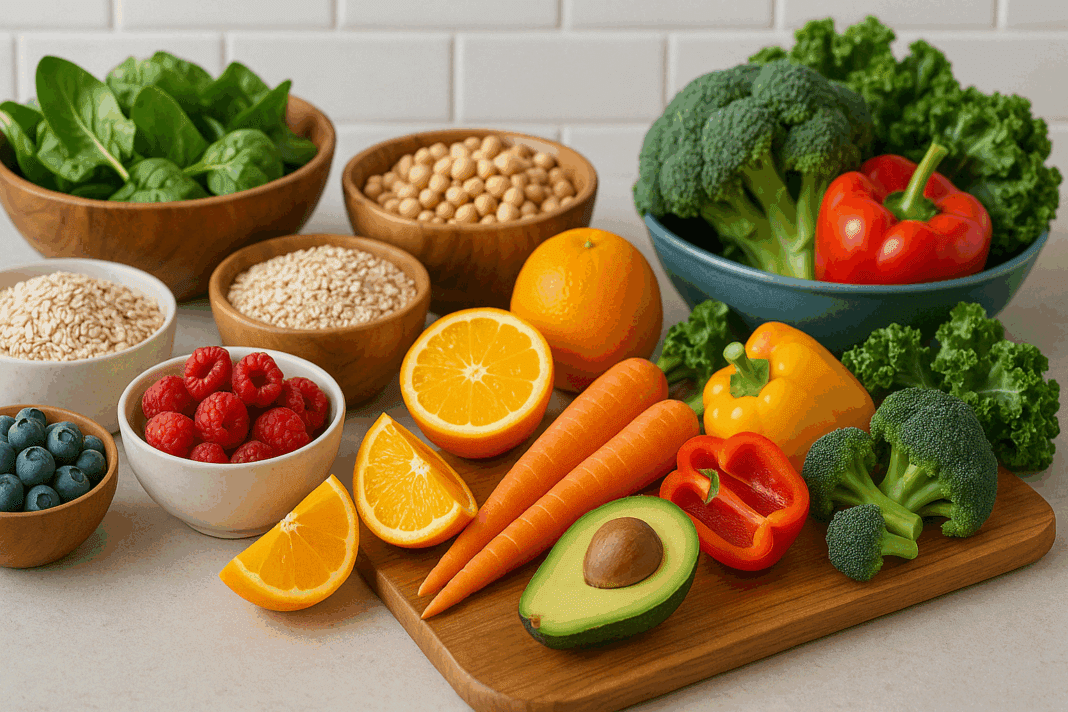In recent years, there has been a growing emphasis on whole-food, plant-based eating patterns as a means to improve health outcomes and support long-term weight management. As evidence accumulates on the relationship between dietary fat intake and chronic disease, particularly cardiovascular disease and obesity, the demand for foods low in fat has surged. Health-conscious consumers are increasingly seeking out plant-based options that are not only low in fat but also rich in essential nutrients and dietary fiber. This article takes a deep dive into the best low fat foods available in the plant-based world, exploring how they contribute to heart health, assist with weight loss, and align with scientific recommendations for healthy living. Through this lens, we’ll also examine how low fat and low sugar foods, non fat foods, and even some high fat low calorie foods fit into a broader nutritional strategy.
You may also like: Plant Based Diet vs Standard American Diet: What the Latest Studies Reveal About Long-Term Health Outcomes
Understanding the Role of Dietary Fat in Health
While fats play vital roles in the body—from aiding in the absorption of fat-soluble vitamins to supporting cell structure—an excess intake of certain fats, particularly saturated and trans fats, has been linked to elevated LDL cholesterol levels and an increased risk of heart disease. The American Heart Association recommends limiting saturated fat intake to less than 6% of total daily calories, underscoring the importance of choosing healthier fats and incorporating more foods low in fat into the diet. Not all fats are harmful, and some, like omega-3 fatty acids found in flaxseeds and walnuts, are actually cardioprotective. However, a balanced approach that prioritizes whole plant foods low in fat and high in fiber has shown consistent benefits for weight management and cardiovascular health.
Plant-Based Eating and Its Impact on Cardiovascular Risk
Whole-food, plant-based diets have consistently been associated with lower rates of coronary artery disease, hypertension, and stroke. These dietary patterns emphasize fruits, vegetables, legumes, whole grains, and nuts—many of which are naturally low in fat or qualify as non fat foods. Clinical research has demonstrated that individuals adhering to plant-based diets often experience improvements in blood pressure, lipid profiles, and inflammatory markers. The fiber content of plant-based foods plays a significant role in this benefit by promoting satiety, regulating blood sugar levels, and aiding in the elimination of excess cholesterol from the body. It is particularly beneficial to include low fat and low sugar foods, such as leafy greens, berries, and cruciferous vegetables, to achieve optimal cardiovascular support.

The Importance of Caloric Density in Weight Loss
When evaluating the role of foods in weight management, caloric density is a key factor. Foods that are high in water and fiber but low in fat tend to have fewer calories per gram, allowing individuals to consume larger portions without exceeding their energy needs. For example, a large bowl of steamed broccoli or a hearty lentil soup provides volume and satisfaction with minimal fat and calorie content. This makes foods low in fat particularly advantageous for those aiming to lose weight or maintain a healthy weight. Interestingly, some high fat low calorie foods, such as avocados or chia seeds, can still support weight loss goals when consumed in moderation due to their high nutrient density and ability to enhance satiety.
What Qualifies as the Best Low Fat Foods?
Identifying the best low fat foods requires considering not only the total fat content but also the quality and nutritional profile of the food. For example, plain oats, quinoa, and legumes such as lentils and black beans are naturally low in fat and packed with fiber, protein, and complex carbohydrates. These qualities make them excellent staples in a heart-healthy and weight-conscious diet. Similarly, vegetables like spinach, kale, zucchini, and cauliflower offer an abundance of micronutrients while remaining virtually fat-free. These foods without fat deliver substantial nutritional value without contributing to excessive calorie intake, making them foundational elements of a whole-food, plant-based lifestyle.
Exploring Foods Without Fat and Their Nutritional Advantages
Many plant-based foods are naturally free from fat, especially those in the fruit and vegetable categories. Apples, oranges, carrots, cucumbers, and tomatoes are examples of foods without fat that offer hydration, vitamins, and antioxidants without added calories. These foods support cardiovascular function by reducing oxidative stress and inflammation while promoting arterial flexibility and blood flow. Additionally, their high fiber content aids in digestion and helps regulate appetite. Incorporating a variety of colorful, non fat foods into daily meals ensures a broad spectrum of phytonutrients, which are plant compounds known to support immune function and disease prevention.

Balancing Fiber Intake with Low Fat Choices
While fiber is widely regarded as beneficial, individuals with certain digestive conditions may need to monitor their fiber intake. In such cases, choosing foods low in fat and fiber may be advantageous. Examples include peeled zucchini, white rice, and low-fiber fruits like bananas or cantaloupe. These foods offer digestibility without compromising a low fat profile. It’s important to tailor dietary recommendations to individual needs, ensuring that even those with sensitive gastrointestinal systems can access nutritious, low fat meals. This highlights the value of diversity within the plant-based spectrum, where options exist for nearly every dietary requirement.
Low Fat and Low Sugar Foods for Blood Sugar Regulation
For individuals managing blood glucose levels or aiming to prevent type 2 diabetes, low fat and low sugar foods are particularly beneficial. These include non-starchy vegetables, such as bell peppers and green beans, as well as legumes like chickpeas and lentils. These foods support glycemic control by minimizing postprandial blood sugar spikes and providing sustained energy release. Whole grains such as barley and bulgur also contribute to this effect, offering slow-digesting carbohydrates without excess fat or sugar. Regular consumption of such foods can enhance insulin sensitivity and reduce the risk of metabolic disorders, especially when part of a comprehensive lifestyle plan that includes physical activity and stress management.

Integrating Non Fat Foods Into Everyday Meals
Incorporating non fat foods into daily meals can be both simple and satisfying. Starting the day with a bowl of steel-cut oats topped with sliced fruit and cinnamon, for instance, offers a nourishing breakfast devoid of fat but rich in fiber and antioxidants. At lunch, a hearty vegetable soup paired with a side of steamed brown rice provides satiety and energy without added oils. For dinner, a stir-fry made with water-sautéed mushrooms, bok choy, and snow peas delivers flavor and texture without the need for high-fat ingredients. Embracing a culinary approach that centers around foods low in fat not only supports weight management but also inspires creativity in the kitchen.
How to Identify Hidden Fats in Packaged Foods
Although many foods are labeled as low fat, it’s essential to read ingredient lists and nutrition labels carefully. Some packaged products contain hidden sources of fat, such as added oils, dairy derivatives, or emulsifiers that can increase the overall fat content despite a low-fat claim. Choosing whole, unprocessed foods whenever possible is the most effective way to avoid these hidden ingredients. When processed items are necessary, selecting those with short ingredient lists and no added oils can help maintain alignment with low fat dietary goals. This awareness is particularly important for those adhering to a plant-based lifestyle with specific health objectives in mind.
High Fat Low Calorie Foods: A Strategic Exception
Not all high-fat foods are detrimental to health, especially when considered within the context of a calorie-conscious, plant-based diet. Certain high fat low calorie foods, such as avocado, nuts, and seeds, offer valuable micronutrients and promote satiety, which can ultimately reduce overall calorie consumption. The key lies in moderation and portion control. A small handful of almonds, for example, provides heart-healthy monounsaturated fats and vitamin E, while remaining relatively low in calories compared to other fat-rich snacks. Including these foods strategically can enhance meal satisfaction and support metabolic health without derailing weight loss efforts.
Why Low Fat Doesn’t Mean Low Flavor
A common misconception about low fat diets is that they lack flavor or culinary appeal. However, plant-based cooking offers a vast array of herbs, spices, vinegars, and natural flavor enhancers that can elevate simple dishes into gourmet experiences. Roasting vegetables with lemon juice and smoked paprika, or creating dressings from pureed roasted red peppers and balsamic vinegar, can add depth and richness without relying on fats. This approach not only supports heart health and weight control but also introduces variety and excitement into the diet. Over time, taste preferences often shift toward appreciating the natural sweetness and complexity of whole plant foods.
Long-Term Sustainability of a Low Fat Plant-Based Diet
Sustainability is a critical factor in any dietary change. A low fat, whole-food, plant-based diet offers the advantage of being both nutritionally adequate and environmentally responsible. By centering meals around legumes, whole grains, vegetables, and fruits—many of which qualify as foods low in fat and fiber—the diet becomes inherently rich in essential nutrients while minimizing ecological impact. Additionally, this way of eating can be adapted to a wide range of cultural cuisines, making it accessible and enjoyable for diverse populations. Its benefits for cardiovascular and metabolic health further enhance its appeal as a long-term lifestyle choice.
Scientific Evidence Supporting Low Fat Plant-Based Diets
Numerous studies have affirmed the health benefits of plant-based diets low in fat. Research from the Lifestyle Heart Trial demonstrated that such a diet could not only halt but potentially reverse coronary artery disease in some patients. Additional findings from large population studies, including the Adventist Health Studies and EPIC-Oxford, have shown that individuals consuming primarily plant-based diets exhibit lower BMI, reduced risk of type 2 diabetes, and improved lipid profiles. These outcomes are attributed in part to the frequent consumption of the best low fat foods, such as leafy greens, legumes, and whole grains. The consistent alignment between scientific literature and dietary practice lends credibility and trustworthiness to plant-based nutritional guidance.
Practical Tips for Transitioning to a Low Fat Plant-Based Diet
For those new to plant-based eating, transitioning to a low fat diet may feel overwhelming at first. Starting with simple swaps—such as replacing mayonnaise with hummus or using vegetable broth instead of oil for cooking—can make the process more manageable. Gradually increasing the intake of foods without fat, such as fruits, leafy greens, and steamed vegetables, helps retrain the palate and improve digestion. Planning meals in advance and keeping nutrient-dense, low fat staples on hand—like beans, lentils, and rolled oats—supports consistency and reduces the temptation to revert to higher-fat, processed options. With time, these changes become second nature and yield noticeable improvements in energy, weight, and overall health.
Choosing Foods Low in Fat for Specific Health Conditions
A low fat plant-based diet can also be tailored to support specific health conditions beyond heart disease and obesity. For individuals with gallbladder disease, pancreatitis, or certain types of liver dysfunction, minimizing fat intake is often a necessary part of treatment. In these cases, selecting foods low in fat and fiber can help reduce digestive strain and alleviate symptoms. Similarly, those recovering from surgery or illness may benefit from lighter, low fat meals that are easy to digest yet nutritionally sufficient. Medical professionals often recommend such dietary modifications based on evidence supporting their role in reducing inflammation, improving recovery, and supporting organ function.

Frequently Asked Questions: Best Low Fat Foods for Heart Health and Weight Loss
1. Can foods low in fat still provide enough energy for an active lifestyle?
Absolutely. Many people mistakenly believe that low fat means low energy, but this isn’t the case when the diet is balanced. Whole grains, legumes, and starchy vegetables—excellent examples of foods low in fat—are also rich in complex carbohydrates, which serve as the body’s primary source of fuel. When paired with lean plant-based protein sources like lentils or tofu, they deliver steady energy without relying on high-fat options. Additionally, incorporating small amounts of high fat low calorie foods like chia seeds can further support endurance without undermining fat-reduction goals. A well-designed plan centered around the best low fat foods can fully support both casual and athletic activity levels.
2. What are some surprising sources of foods without fat that people often overlook?
Many everyday plant-based foods are naturally fat-free, yet they are often underestimated. For instance, mushrooms, turnips, and radishes are all considered foods without fat, but they’re also rich in minerals, antioxidants, and unique phytochemicals. These ingredients can easily be added to soups, stir-fries, and salads for extra volume and nutrition without contributing to fat intake. Even fresh herbs like parsley and cilantro—also non fat foods—boost flavor while supporting detoxification and immune health. Exploring these lesser-known fat-free foods can enhance dietary variety while staying aligned with health goals.
3. How can someone with a sensitive digestive system navigate foods low in fat and fiber?
Individuals dealing with IBS, ulcerative colitis, or recovering from gastrointestinal procedures often need to choose foods low in fat and fiber. Cooked zucchini, peeled potatoes, and white rice are ideal in these cases, offering a gentle option that won’t irritate the digestive tract. Pairing these with easily digestible proteins like silken tofu or split mung beans creates meals that are nutritionally balanced and easy to tolerate. While fiber is beneficial for most, people in specific medical scenarios can still find nourishing, low fat solutions without high fiber content. It’s crucial, however, to work with a dietitian to ensure nutritional adequacy during such restricted phases.
4. What is the role of non fat foods in emotional eating and satiety?
Non fat foods like berries, leafy greens, and steamed vegetables can play a valuable role in addressing emotional eating. Their volume, texture, and vibrant colors engage the senses and contribute to feelings of fullness without contributing to caloric overload. When paired with mindfulness practices such as chewing slowly and eating without distractions, these foods help break the cycle of eating for comfort rather than hunger. They also help stabilize blood sugar, reducing mood swings that can trigger cravings. Over time, including these foods low in fat can reframe one’s relationship with food from reactive to intentional.
5. Can low fat and low sugar foods support cognitive performance?
Yes, emerging research suggests that nutrient-dense, low fat and low sugar foods can positively influence brain health and function. Foods like lentils, spinach, and sweet potatoes provide a steady release of glucose to the brain without the inflammatory effects of sugar and saturated fat. Meanwhile, fortified plant milks and leafy greens supply folate, iron, and B vitamins critical for neurotransmitter production. The key is ensuring the overall diet includes enough complex carbohydrates and micronutrients, especially when reducing dietary fat. Maintaining cognitive clarity is fully compatible with a well-planned diet based on the best low fat foods.
6. How do high fat low calorie foods fit into a predominantly fat-conscious diet?
Strategically incorporating high fat low calorie foods can enhance both nutrition and satisfaction, even on a primarily low fat plan. For instance, a small portion of avocado or a sprinkle of ground flaxseed on oatmeal adds heart-healthy fats, fiber, and bioactive compounds. The richness of these foods helps regulate appetite and supports nutrient absorption, particularly for fat-soluble vitamins like A, D, E, and K. The key lies in portion control and frequency—not eliminating fat altogether. In this way, the diet remains centered on foods low in fat while gaining essential benefits from high-quality fat sources.
7. Are there any cultural or regional diets that emphasize foods low in fat and fiber?
Yes, several traditional diets emphasize naturally low fat, low fiber ingredients, particularly in healing or ceremonial contexts. For example, certain East Asian recovery diets rely on rice porridge (congee), which is low in fat and easy to digest. Similarly, in Ayurvedic cuisine, kitchari—a simple dish made of white basmati rice and yellow mung dal—is favored during detoxification periods and illness recovery. These meals are culturally rooted, nutritionally intentional, and aligned with principles of balance and ease of digestion. They reflect longstanding wisdom that mirrors modern science’s understanding of foods low in fat and fiber in therapeutic contexts.
8. How can people identify the best low fat foods in a grocery store without reading every label?
Learning to visually recognize unprocessed whole foods is a valuable skill that simplifies grocery shopping. Fresh produce—particularly vegetables like squash, cabbage, and carrots—almost always qualifies as foods low in fat. Dried legumes, whole grains in their intact form (like quinoa or barley), and plain plant-based milks with no added oils are also safe bets. Meanwhile, frozen fruits and vegetables without sauces or seasonings offer convenience without sacrificing nutrition. Familiarity with these food categories allows consumers to confidently choose low fat and low sugar foods without exhaustive label reading.
9. What are some creative ways to cook with non fat foods that still feel indulgent?
Non fat foods can be transformed into indulgent, satisfying meals through cooking techniques and thoughtful pairings. Roasting cauliflower with smoked paprika and lemon juice creates a deep umami flavor without needing oil. Blending roasted butternut squash with garlic and plant milk produces a velvety soup base that rivals cream-based recipes. Even desserts can benefit—for instance, using frozen bananas as a base for fat-free “nice cream” offers a decadent treat without added fat. Such approaches let foods without fat become the stars of the plate, proving that low fat doesn’t mean low flavor or creativity.
10. What future trends in plant-based nutrition might impact the use of low fat foods?
As research continues to evolve, there’s increasing interest in how low fat plant-based diets interact with personalized nutrition, microbiome science, and digital health tools. Innovations in food technology are also making it easier to develop satisfying low fat alternatives to traditionally high-fat products. We’re seeing more chef-led meal services focused on whole-food, low fat and low sugar foods tailored to specific metabolic profiles. Additionally, public health campaigns are starting to prioritize sustainable, accessible non fat foods to address diet-related illness at scale. These trends indicate that the future of foods low in fat will be increasingly diverse, personalized, and supported by both science and technology.

Conclusion: Embracing the Best Low Fat Foods for a Healthier, Plant-Based Future
Embracing the best low fat foods within a plant-based framework offers a powerful strategy for enhancing both heart health and weight management. By focusing on whole, nutrient-dense ingredients such as vegetables, legumes, and whole grains, individuals can enjoy foods low in fat that support optimal metabolic function, improve cholesterol levels, and promote satiety. Integrating non fat foods and low fat and low sugar foods into daily meals not only reduces disease risk but also nurtures a relationship with food grounded in mindfulness and sustainability. While high fat low calorie foods can be included strategically, the emphasis on minimally processed, plant-based options remains central to achieving long-term wellness. The evidence supporting low fat plant-based diets is robust and continues to grow, reinforcing their role as a cornerstone of preventive medicine and holistic health. Ultimately, choosing foods without fat or those low in fat and fiber is not about deprivation, but about unlocking the full potential of what a compassionate, evidence-based approach to nutrition can offer. For those seeking a lifestyle that nourishes both body and planet, the path forward is not only clear but also deeply rewarding.
Was this article helpful? Don’t let it stop with you. Share it right now with someone who needs to see it—whether it’s a friend, a colleague, or your whole network. And if staying ahead on this topic matters to you, subscribe to this publication for the most up-to-date information. You’ll get the latest insights delivered straight to you—no searching, no missing out.
Further Reading:
Heart-healthy diet: 8 steps to prevent heart disease
What is a plant-based diet and why should you try it?
The right plant-based diet for you
Disclaimer
The information contained in this article is provided for general informational purposes only and is not intended to serve as medical, legal, or professional advice. While NewsHealthWatch strives to present accurate, up-to-date, and reliable content, no warranty or guarantee, expressed or implied, is made regarding the completeness, accuracy, or adequacy of the information provided. Readers are strongly advised to seek the guidance of a qualified healthcare provider or other relevant professionals before acting on any information contained in this article. NewsHealthWatch, its authors, editors, and contributors expressly disclaim any liability for any damages, losses, or consequences arising directly or indirectly from the use, interpretation, or reliance on any information presented herein. The views and opinions expressed in this article are those of the author(s) and do not necessarily reflect the official policies or positions of NewsHealthWatch.

